Looking to save space and resources while growing plants? Consider hydroponic gardening. While pool noodles may seem like a convenient option for starting seeds in your hydroponic garden, they come with a caveat. These foam swimming accessories could inadvertently leak rainwater into your deep water culture (DWC) systems when used as supports, potentially diluting the nutrients crucial for your plants.
Despite this drawback, pool noodles can serve as effective supports for larger plants like tomatoes. By cutting and angling the noodles when inserting them into a DWC system, you can prevent rainwater from collecting and seeping into your hydroponic setup. It's essential to be mindful of how you position the pool noodles to avoid water leakage. Additionally, opt for high-quality pool noodles to prevent chemicals like polystyrene and polyvinyl chloride (PVC) from leaching into the water over time and potentially harming your plants.
Issues Arising from the Use of Pool Noodles in Hydroponic Gardening

Rainwater infiltration into a hydroponic garden may appear harmless at first glance. However, when utilizing pool noodles in such a setup, it can disrupt the system's equilibrium. The entry of rainwater through pool noodles dilutes the nutrient concentration and may introduce debris or minerals that could adversely impact the hydroponic system. Hydroponic gardens heavily rely on maintaining a stable pH level and ensuring the correct nutrient balance due to the absence of soil for nutrient uptake.
Even minor alterations in the system composition, like excess rainwater from pool noodles, can lead to pH fluctuations. Significant shifts in pH levels can hinder the plants' ability to absorb essential nutrients from the water. While pool noodles have the potential to create issues in certain hydroponic gardens, there are several methods to incorporate this foam material effectively into hydroponic systems without causing disruptions.
Optimizing the Use of Pool Noodles for Hydroponic Gardening

When employed correctly, pool noodles can serve as valuable assets in hydroponic gardening. By strategically positioning pool noodles within the system, they can provide support to plants, aid in water circulation, and act as barriers to prevent light penetration that could trigger algae growth. Properly utilizing pool noodles can enhance the efficiency and effectiveness of a hydroponic setup, contributing to healthier plant growth and optimal nutrient absorption.
Are you setting up a deep water culture system for your plants? Pool noodles can still serve as great supports, depending on how you utilize them to secure your plants. When dealing with a DWC system, it's crucial to ensure it is properly sealed to prevent any water or sunlight infiltration. For an indoor hydroponic garden, there's no need to worry about rainwater seeping in through the pool noodles; you can insert them diagonally on the container's side. However, this setup may not be ideal for outdoor use.
If you already have a container or bucket with holes for your plants, consider cutting the foam into thick discs that snugly fit into the holes. This way, your plant can protrude from the system without the noodle acting as a funnel. To ensure your plant remains upright, additional support such as a trellis or ties may be necessary. Alternatively, you can create holes in the container's lid and insert the foam discs there for a secure fit. If there's empty space in the noodle's center, consider using rockwool or another container gardening substrate to fill it. If pool noodles aren't your preference, try using net pots to support your plants instead.







